pro·hi·bi·tion
noun
- 1.the action of forbidding something, especially by law
- 2.the prevention by law of the manufacture and sale of alcohol, especially in the US between 1920 and 1933.

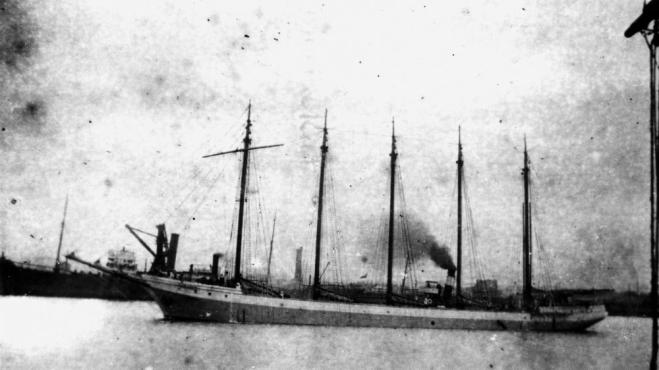





Crumble is not afraid to be seen, even if she does turn her head when the camera is on. The faithful labrador of Torrisdale Castle is never far from Niall’s side. Exclamations of ‘Crumble!’ delivered in varying pitches and intonations interrupt the quietude in this remote corner of Scotland. Kintyre feels like an island, the isthmus the only flaw in the plan. It is quirky, rugged, wild and mild, with giant flora and palm trees flourishing due to the warmth of the Gulf Stream. Fauna is also plentiful, hardy hedgehogs cross the road with little to fear as there are more cows than cars.


I fell in love with Kintyre while developing the recipe for Kintyre Gin. A return visit allowed me to check on progress and catch up with the wonderful people of Beinn An Tuirc (‘Hill of the Wild Boar’ in Gaelic) Distillery. Niall and Emma, the Torrisdale tag team driving the project forward, were in good spirits. Early gin sales have exceeded expectations, so much so that Niall has purchased a ‘Boar Bus’ to keep up with gin deliveries. The former piggery buildings have been given a new lease of life producing the new spirit of the wild boar.

This sustainable distillery has impressive green credentials, with ‘Big Don’ (the gin still) powered by the torrent of water rushing down the burn from the hills above the estate. Since its inception, the hydro scheme has generated enough electricity to power 7.5 million kettles! Beinn An Tuirc is flying the flag for sustainable craft distilling in Scotland.

My good friend and Head Distiller Su Black (Heriot-Watt University alumnus) has been putting big Don through his paces, distilling and filling the attractive bottles with flavoursome spirit. The clink of empty bottles at the end of the visit attested to the gin’s high drinkability. Crumble nodded her approval as she sat in her armchair. Kintyre Gin is produced by a passionate, innovative and endearing team and deserves your attention whenever mulling Kintyre.

Links:

The West Coast Trail is ranked among the top hiking routes in the world. The 75km trek along the rugged western coast of Vancouver Island is a challenging proposition. The route from Gordon River to Pachena Bay includes river crossings, ladders and cable cars. Only 30 passes per day are issued for each access point during the open season, from the 1st of May until the end of September. Of the 6,000 hikers attempting the trail each year about 1 to 2% require rescue. The remote location may result in a long wait for salvation, therefore a warming island spirit is an indispensable hiking companion.
Before I embark on such an arduous mission, I will need to build up some familiarity with the land and its people, and road test the local spirits to rejuvenate aching legs. I thus ventured forth to discover the distilleries of Vancouver Island that might be able to assist in my quest.
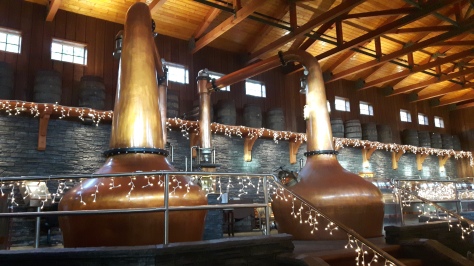
Shelter Point Distillery is a remarkable place. Nestled along the island’s eastern shore near Oyster River, Patrick Evans has converted his farm buildings into a whisky wonderland. The shiny Forsyth stills made in Scotland stand prominently in the high ceiling barn. They feast upon green barley grown right in front of the distillery. The cask strength whisky exemplifies the potential of BC to produce some of the best whisky in the world. Pure water, clean crisp air, temperate climate, the influence of the sea and wholesome grain. The landscape is like the west coast of Scotland, but with more trees!

Wayward Distillation House in the heart of Comox valley has created a buzz in BC with its use of honey as a substrate for fermentation. This was the first time I encountered a whole distillery run on bee nectar. The honey is locally sourced and tastes divine. The distillers are honey bears in spirit and commented on how everything ‘gets so sticky… in a good way’. I also liked they way they gave their tanks personalities by naming them, e.g. ‘Wee Man’ for the small spirit receiver.

Arbutus Distillery in Nanaimo is notable for its gnarly ‘Babayaga’ absinthe and finely crafted spirits. Michael Pizzitelli, master distiller, with an MSc in Brewing & Distilling at Heriot-Watt University, has a background in natural sciences. This has helped him achieve a quality of spirit that will be welcome on any hike. Upon researching the etymology of ‘Babayaga’, I discovered it’s a supernatural being from Slavic folklore who appears as a demented woman flying around in a mortar and waving a pestle, who lives in a forest hut and has chicken legs… gnarly indeed!

Lastly, Sheringham Distillery, is the real deal of West Coast Trail distilleries. The distillery is perched on a hill overlooking the wild Pacific in the heart of prime surfing territory near Jordan River. Jason, the founder and head distiller, combines his passion for distilling and surfing in the most sublime of locations. The production facility in a rustic wooden building is where Jason and John produce gems such as Seaside Gin, chocolate vodka and a double distilled new grain spirit. The new grain spirit is a tantalising glimpse into the whisky to follow in a few years time.

Having completed my mini west coast distillery trail there was time for a warm up hike on the Juan de Fuca trail. A 4km jaunt to Mystic Beach and back with a rope swing thrown in for good measure. As all hardy hikers know, the best part of any hike is a rewarding dram at the end!

The whisky community thrives in Victoria. In the short time since my arrival in Canada I have been invited to numerous whisky events. The best named event so far is ‘Scotchpocalypse’. This gathering of the faithful involved everyone bringing a bottle of single malt Scotch to the table. The bottles were lined up and sampled in turn, with a wee bit of discussion about each one. Of course, by the time you get to the fifth or sixth all the formalities are thrown out of the window and it descends into a house party.

The Scotch Malt Whisky Society (SMWS) is present in town too. Held monthly at the Strathcona, every tasting I have been to so far has been sold out (approximately 50 seats). There is a palpable buzz around the room as each whisky is announced following a blind tasting. Demand is so high for the bottles that most are snapped up within minutes of being revealed. This is despite prices being far higher than what I am used to back in Scotland. A typical 10 year old will go for C$170 (£110) and older whiskies typically C$250 (£160) and beyond.

Even in sleepy Sidney there are some great whisky events to be had. I am now a ‘member in good standing’ with the Sidney chapter of the International Order of the Companions of the Quaich. The effort put in by Thom and Viola into the tastings is outstanding. A booklet is produced that details tasting notes, fun facts and distillery profiles. Last month we enjoyed a vertical tasting of Glen Garioch, including the rare Vintage 1995 which was the last to use peated malt. I am even more excited however by what is to come – a Supernumeracy Brora tasting. Brora distillery in north-east Scotland closed in 1983 and is a precious find in any whisky bar. The chance to try these rare whiskies 5,000 miles from their origin is an unusual privilege.

In January, Victoria will host its annual international whisky festival. Representatives from distilleries around the world will be present to show off there spirits and meet friends old and new. I have been asked to be part of one such event, representing Victoria Distillers at the tasting and discussion panel of BC distillers. I can’t wait to be a part of it. People will willingly queue at 2am in the morning to grab tickets for master classes when they are released next weekend. I am most impressed by the dedication and determination of whisky-mad Victorians to ensure a place at the official ‘Scotchpocalypse’!
http://www.victoriawhiskyfestival.com/

Two and a half years ago I left the banking industry for the last time not knowing where the distilling journey would lead. All I knew was that being part of the whisky industry is something that I would enjoy every day. I had no idea that I would end up 5,000 miles away in a little place called Sidney. The number plates on local cars proclaim ‘Beautiful British Columbia’ – and they are not wrong. The west coast of Canada is blessed with gorgeous islands, stunning coastline and an abundance of incredible wildlife. Victoria Distillers (formerly Victoria Spirits) moved from their forested location in central Saanich to the seafront in Sidney earlier this year. The new owner has grand ambitions to grow the brand in Canada and the US. With such an interesting proposition and wonderful location I jumped at the chance to join the distilling team.

Craigdarroch whisky may not be familiar to you yet, but one day I hope my contribution will bring it international recognition as a malt reflecting the character of Vancouver Island. A small batch was released a couple of years ago and sold out almost immediately. The delectable whisky has a lovely banana note. With a new seaside location I hope maturation will bring further coastal complexity to the whisky.

The new role is a great opportunity to be creative in other areas too. The existing products include Victoria Gin, Oaken Gin, Hemp Vodka, Eau de Vie and a selection of Bitters. This week we have also begun production of a chocolate liqueur and trials of a spiced rum. With all these different spirits the head bar tender has done a great job of putting together a cocktail list to suit all palates for customers in the distillery lounge.

The lifestyle is very laid back, which suits me perfectly. I live a a simple life with hardly any possessions. I have no car and no bike, my sole mode of transport is my skateboard. I have no TV and no bills to pay as everything is included in my minimal rent. The team at work are great, fun and friendly. I have a free gym pass at work (which I sometimes use), but most of my free time is spent socializing in the local bars or exploring my new surroundings. All in all, life is good in Beautiful British Columbia!


Nick Morgan serenaded us with a whimsical rendition of ‘Riders in the storm’. The Paps of Jura broke through wispy clouds across the Sound of Ila. A festival edition of Caol Ila in hand. How extraordinary. Even more impressive was the Australian gentleman in the crowd who had made the pilgrimage every year for the last eight years…such is the pull of Feis Ile.


My first ever Islay whisky festival coincided with the 200th anniversary of Lagavulin. A 3 hour queue for the festival bottling was avoided. I made a promise to myself not to get caught up in the buying frenzy and to instead focus on soaking up the atmosphere of this very special occasion. I loved the cooperage display and speaking to enthusiasts from all over the world. So many good stories and so many happy faces. The drams flowed freely from the distillery but also amongst the whisky geeks. Sample bottles emerged from clunking bags and eyebrows raised with interest at each new arrival.

At Bruichladdich, the locals came out in force. We were treated to a wonderful performance from the pipeband and a dram of ‘Yellow Submarine’. I took an impromptu tour of the distillery and got acquainted with ‘Ugly Betty’, the Lomond still used for The Botanist gin. The highlight of the day was sampling a 23 year old rare malt Port Ellen which appeared out of nowhere from a friend of a friend. Serendipity and the stuff you can’t plan is the part I enjoy the most about these gatherings of the faithful!
With hitch-hiking proving to be the best way around the island, I headed for Port Ellen maltings. A fascinating peek at the inside of drum maltings and the wonderful smell of peat smoke roaring through the kilns. It proved to be a welcome addition to the distillery events and added an element of education to the festival experience.
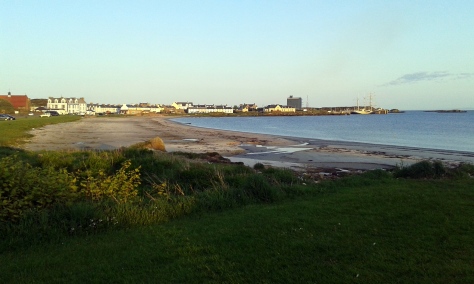
I wish I could have stayed for the full eight days but a four day trip had to suffice. I have no doubt I will be back as Islay is whisky Mecca and the Feis Ile is whisky Hajj. To all the Ilachs dedicated to organising such a remarkable festival, I raise a dram to you. Lang may yer lum reek Feis Ile!

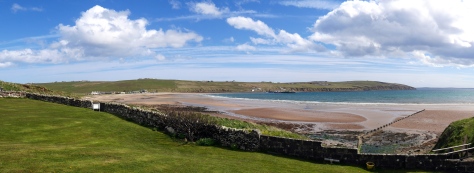
The institute of Brewing & Distilling expedition continued onwards to Scapa Distillery. Orcadian beauty is abundant on the shores of Scapa Flow. The bay reflects the moods of the weather. We were blessed with shimmering water in glorious sunshine. But even the brightest of days is overshadowed by the tragic events that unfolded within view of the distillery. The green buoy in the bay marks the site where the Royal Oak was sunk during the second world war with the loss of 834 lives. 70 unwanted ships were intentionally sunk to form ‘Churchill’s barriers’ in an attempt to prevent further losses for the navy stronghold. The sense of history in Orkrney provides a powerful context for the production of whisky.

Scapa Distillery recently opened to visitors for the first time so we were excited to get a first peek. Of most interest for me was the Lomond still, the only one used for single malt Scotch whisky. Installed in 1959 it had three internal plates which could be varied to produce 3 different types of spirit. The plates have now been removed resulting in a more standard setup for wash distillations. The spirit still is dwarfed by the beastly Lomond still. A strange couple that work in unison to produce a wonderful spirit. Scapa was also famous for its remarkably long fermentation of 160 hours (compared to 48 hours for most). This helped impart the estery profile to Scapa 16 year old. Unfortunately, recent capacity constraints have led to a reduction in the fermentation time to 80 hours and the discontinuation of the 16 year old. We sampled the new NAS expression ‘Skiren’ at the end of the tour and boarded the bus bound for Scapa’s famous neighbour.


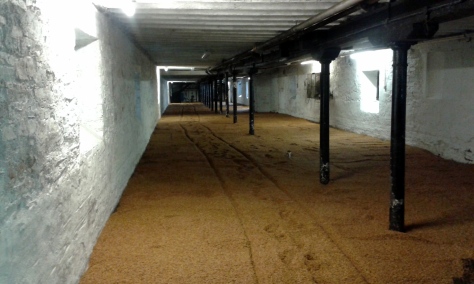
Highland Park is must on any distillery baggers’ hit list. Dominating the skyline on the outskirts of Kirkwall, Highland Park offers the visitor a comprehensive view of whisky production. Locally cut peat, malting floors, mashing, fermentation, distillation, maturation, cooperage… it’s all here. As you pass through the famous gates with their intricate ironmongery you are greeted by a team proud of their whisky and Orcadian heritage. Our guide took delight in retelling the dangers of peat cutting – an unexploded bomb and axe head have been discovered. Further testament to the palimpsest of history unique to these islands. Viking strength is required to maintain the malting floors as the barley is turned every 4 to 8 hours. The result of all their hard work is 44,000 barrels on site, or 9 million litres of spirit. No wonder the entrance gates are so imposing with all those thirsty locals out.
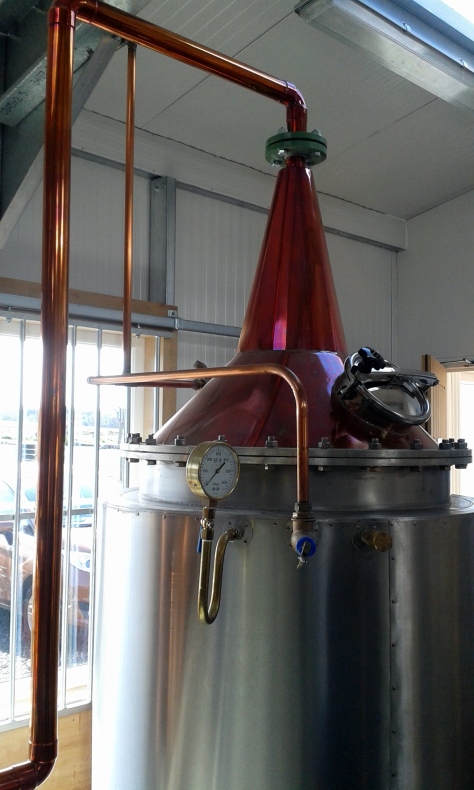

Returning to mainland we stopped by a distillery of great contrast, but no less impressive. Dunnet Bay has only been open 18 months but such is its success in the craft gin boom that its latest seasonal gin was sold out even before it left the building. The 500L John Doe still looked like the tin man from the Wizard of Oz and is producing magical spirit. Rock Rose gin is winning many awards due to the dedication of Martin and Claire – a couple who followed their dreams and ditched their former careers. In the last year 35,000 bottles were sold, an incredible achievement for a small start-up craft distillery. Long may it continue.
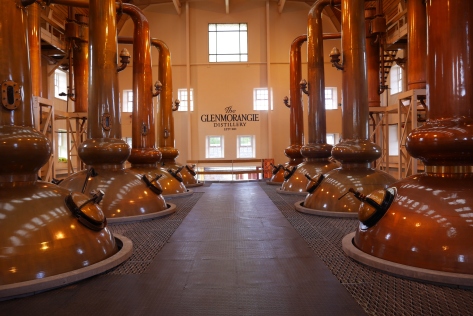
The final destination on our epic Viking voyage was Glenmorangie in Tain. The sense of grandeur in the still room was breathtaking. Twelve of the tallest stills (5.1m) in Scotch whisky give the impression that you were in a cathedral of distillation. Necks creek in the same way as they would in St. Giles. Also impressive was the construction of the new Anaerobic Digestion plant at a cost of over £20m. The facility will treat effluent reducing the distillery’s impact on the environment and will produce methane from stillage which can be used to offset energy bills. We finished off with a great tasting that showcased some of Glenmorangie’s more innovative offerings such as Signet, which contains chocolate malt.

We successfully completed our Viking mission – 5 distilleries and 2 breweries in 3 days. It’s hard work, but someone has to do it!
To ‘go-a-Viking’ means to go raiding for loot. The Institute of Brewing and Distilling annual trip was titled ‘The Viking Tour’. For £250 it was possible to ‘raid’ 6 distilleries and 2 breweries over three days with all accomodation and travel included. A coach filled with 21 like-minded viking raiders headed north with a thirst for knowledge and liquid refreshment.
The first stop was Invergordon Distillery. The industrial scale of the distilling columns and the smell of dark grain processing made an immediate impression. It was my first visit to a grain distillery and it presented a welcome contrast to slick touristic malt distilling operations. Invergordon is the workhorse of Whyte & MacKay, pumping out up to 40 million litres of pure alcohol per annum from a mixture of barely and maize. It’s muscular exterior masked a soft, delicate centre. The 1974 single cask we tried was smooth, complex and had a lusciously long finish. The distillery was also notable for its unusual continuous fermentation system. Reduced downtime and faster fermentations can result in considerable cost savings due to lower energy consumption.
We continued up the A9 to Wick and pulled in to Pulteney Distillery. This northern classic is plonked in the middle of the old town of Pulteney. The surrounding houses and local businesses give the distillery a lovely community feel and give the impression that they are protecting their most prized asset! Most of the whisky is matured on site which is believed to enhance the whisky’s salty, sea air character. As no peated malt is used and Old Pulteney has a heavy coastal character I am inclined to agree. After the tour we were invited to try the 12, 17 and 21 year old expressions. All delicious but the 17 was my favourite on the day.

Day 2 and an early start for a bit of sightseeing around Orkney. The last time I was here was 20 years ago and I was soon reminded of why I loved it so much the first time. A cocktail of neolithic archaeology, war history and rugged, treeless landscapes gives Orkney its unique atmosphere. The Ring of Brodgar, a UNESCO World Heritage site, seemed to trap us in its stoned circular trance. What? Why? and How? Only those alive 4,500 years ago will know for certain. Ask an archaeologist today and you are likely to hear ‘ritual monument’, which is the generic term used whenever they don’t have a clue!
At 9:30am our longboat landed at Swannay Brewery. Beer was served for breakfast in the Viking tradition. Rob Hill, owner and self professed ‘plodder’ has been brewing here with passion for 10 years. When you meet people like Rob you are reminded why the craft revolution is a great boon for the drinkers of today. All he wants to do is make great beer, everything else is secondary. He sincerely said, “As long as you have a good pint in your glass, I’m a happy man”. Here, here Rob!
The now considerably more boisterous raiding party continued to Orkney Brewery. We were welcomed with a delicious selection of beer. I particularly enjoyed the Red MacGregor and the Dark Island Reserve aged in a whisky cask was rich and curious (although something I would not normally drink at £20 per bottle!). The brewery is state of the art with a gleaming brewhouse and fermenters, creating 36,000L per week. Orkney Brewery is a great example to what can be achieved with Viking spirit to all other budding start-up breweries. Tune in again soon for Part 2…..
…Sitting on the Wall.
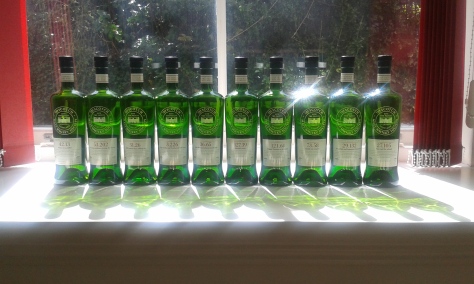
Each empty bottle reflects the passing of time and the true nature of impermanence. Every one of these green soldiers is gone forever. Each a single cask whisky and each like a snowflake – never to be repeated again. Most casks contain only 200-300 bottles and I am unlikely to acquire another. Like the passing of clouds, lightning and morning dew the only constant is change. I could mourn the loss of each of these marvelous drams, stuck in melancholy and attachment to the past. However, I rejoice in the fact that I was alive when mother nature and humankind combined to produce such exquisite, delectable spirits.
I compare the experience of drinking single cask whisky to the creation of a Mandala. Buddhist monks will spend days carefully painting with sand, producing detailed and intricate geometric shapes, only to wipe them away in an instant upon completion. Art is used as a metaphor to be mindful of the transient nature of life.
Every cask’s journey started in the fields and rivers. Water and barley subject to the climatic and environmental conditions of the time. Then, differing production techniques take over. Floor maltings, drum maltings, Saladin boxes, still shapes, fermentation times, heating sources, wooden washbacks, stainless steel washbacks to name but a few. Then, selection of the cask – Bourbon, Sherry, Port, Wine, Rum. The number of variables is limitless. Years pass in a changing world and then finally the spirit must pass its final test….. The Tasting Panel. Only then will it be bottled by The Scotch Malt Whisky Society and made available to members around the world. What an incredible journey, and what a wonderful privilege to experience malts so unique and rare. Single cask whisky rewards the serendipitous adventurer. The senses await in anticipation as to what organoleptic delights the next ten green bottles might bring!
The 10 whiskies were:

The 2016 Institute of Brewing and Distilling (IBD) AGM took place at the James Hutton Institute (JHI), Invergowrie, a short hop from Dundee, the ‘City of Discovery’. With my £9.50 Megabus ticket, I boarded at Edinburgh bus station. 90 minutes later, Dundee emerged in all its sunny glory. The construction site on the waterfront is testament to exciting times ahead. Urban regeneration and the arrival of the V&A will transform the former capital of Jute and Jam.
Dundee is also a mecca for agricultural science. The Life Sciences department at the University of Dundee is world renowned for its research in molecular biology and the JHI undertakes pioneering work in crop genetics. The Institute’s work in barley and hops is relevant to the brewer and distiller.
7.3 million tonnes of barley were produced in the UK in 2015, worth approximately £1bn to the UK economy. The JHI uses its climate controlled glasshouse and farm trial facilities to improve our understanding of barley genetics. Commercial breeders use this information to be more effective in their pursuit of new barely varieties. The holy grail is to find new varieties with higher extract yields, improved malting characteristics and increased pest/disease resistance. Current projects include improving hot water extract of Winter varieties relative to Spring varieties and targeting genetic markers to improve saccharification of starch in the mashing process. For example, a reduction in arabinoxylan and beta-glucans in cell walls can be achieved by crossing varieties with particular traits, consequently improving enzyme access to polysaccharides contained within the cell matrix.
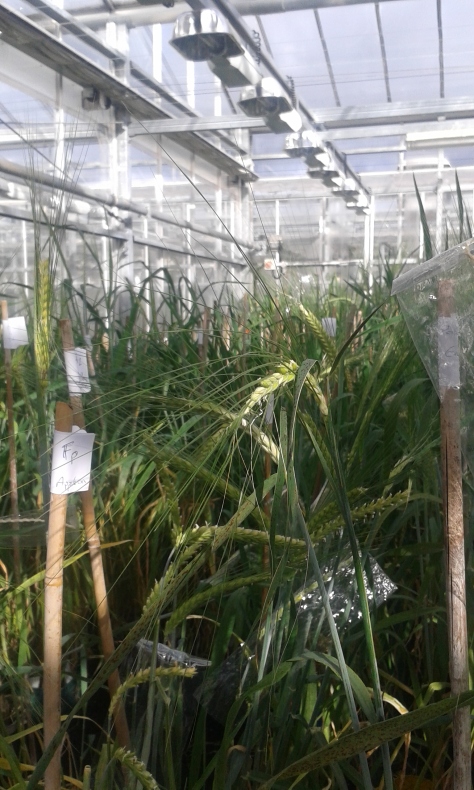
The JHI work on hops resulted in the first successful trial of Scottish hops last year. There was a small hop industry in Scotland until 1878, but now the majority of the UK’s hops are grown in Kent. UK production is currently less than 1,000 hectares and is approximately 2% of global hop production. With rapid growth in the number of Scottish breweries (currently 93) there is renewed interest in creating an entirely ‘Scottish’ product. Hence the drive to successfully cultivate Scottish hops. THE JHI used a Haygrove polytunnel and drip fertigation to produce a hand-harvested hop with 3.8 alpha-acid content. The aroma is good but because an unregistered fungicide was used during the trial they are unfortunately unavailable for commercial beer production. The JHI aims to progress further trials this year and will hopefully be able to produce a commercially viable crop. I managed to get my hands on one of the 400 bottles of privately produced beer made with the 2015 Scottish Hops. A refreshing pale ale with lots of promise and a pleasant hop taste. As the crop is hand-harvested it is labour intensive. Any help with the 2016 harvest in September would be much appreciated!

In its quest to cement its position as a global leader in agricultural science, the JHI has submitted proposals to the UK government to create a new ‘International Barley Hub’ (IBH) at the Dundee site. At a cost of £36m the new centre is expected to produce a return of £700m in 12 years. The IBH aims to alleviate global hunger by increasing usable land for crop production from 3% of the world’s land area to 12%. This increase would come from more genetically robust cereal varieties thriving in currently marginal agricultural land. The elephant in the room is ‘GM’. Currently, no GM crops are permitted in full-scale field trials, only laboratory and glasshouse trials.
The JHI is a fascinating place for a visit and it is great to see so many agricultural innovations taking place that will benefit not just Scotland, but the world. On the dirt cheap Megabus on the way home I realised that the dirt in Dundee will potentially affect the whole of humanity in the most positive of ways!
